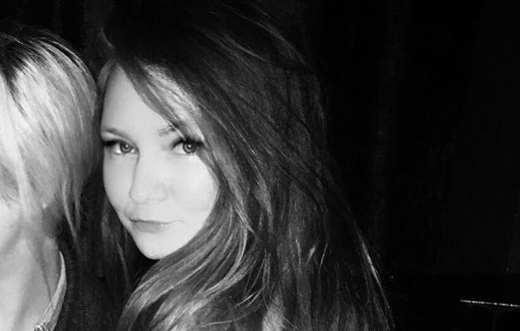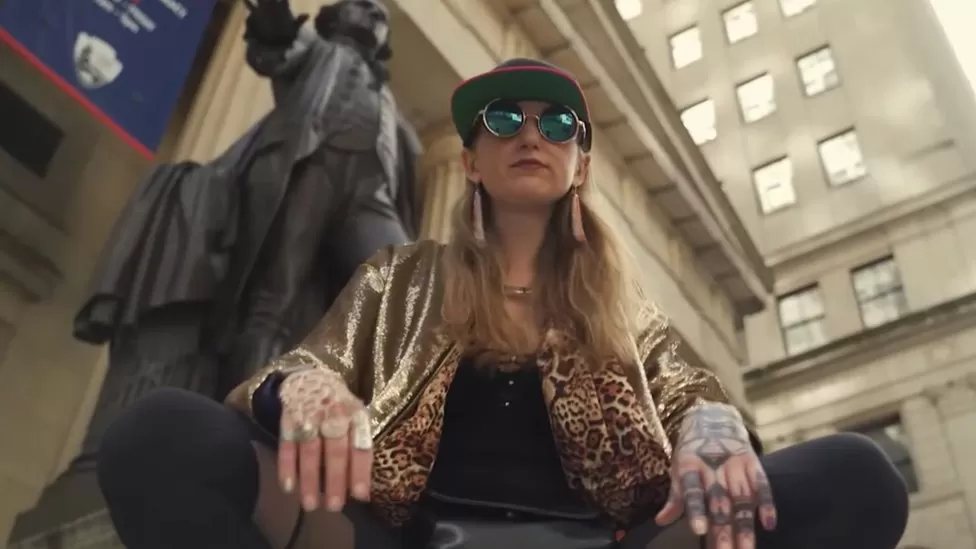
Just how far can you get in the New York City socialite scene without a real fortune of your own?
Incredibly far, in the case of Anna Delvey – real name Anna Sorokin – who allegedly tricked the city’s elite into thinking she was a billionaire heiress. She reportedly hired a private jet, went to all the best parties, and threw cash at everyone she saw – a $100 (£78) tip if you carried her bag or were her Uber driver.
Yet, ultimately, her time at the top was short-lived. And it unravelled spectacularly.
In real life, Ms Sorokin had no multi-million-dollar trust fund. According to New York Magazine, her father is a former trucker, who runs a heating-and-cooling business.
After her credit cards began to fail – repeatedly – and she was kicked out of the luxury hotels she lived in, other people were left to pick up the extortionate bills, according to the Manhattan District Attorney’s office.
Following a month-long trial, Ms Sorokin has now been found guilty of multiple offences, including stealing more than $200,000 – after racking up debts and fraudulently trying to secure major bank loans.
“As proven at trial, Anna Sorokin committed real white-collar felonies over the course of her lengthy masquerade,” District Attorney Cyrus Vance said in a statement announcing the conviction.
Ms Sorokin, who chose not to testify and pleaded not guilty, now faces up to 15 years in prison and will be sentenced on 9 May.
So how did this woman in her mid-20s allegedly cause financial chaos across a city, leaving people picking up her tabs in the US and beyond?
‘Faking it’
Anna Delvey came to New York City on a mission. At least that is what she told people.
She wanted to start an arts centre, with a chic Soho House ethos. She was considering calling it the Anna Delvey Foundation, according to New York Magazine, and she claimed to have lined up renowned artist Christo for the inauguration. For the venue, she had her eye on a six-floor space – 45,000 sq ft (4,200 sq m) – in Church Missions House, a prestigious, late 19th Century building, on the corner of Park Avenue and 22nd Street.
There is a certain lifestyle that goes with such bold claims – and she was living it.
Speaking at the trial’s opening, defence lawyer Todd Spodek said: “Anna had to fake it until she could make it.”
He told jurors that Ms Sorokin was “easily seduced by glamour and glitz” when she saw how wealth – or the illusion of wealth – opened doors.
According to court documents, Ms Sorokin represented herself as a German heiress with $60m in assets to try to get a loan of $20m for her foundation. She allegedly presented forged bank statements and would also deposit bad cheques, then withdraw the money before they bounced.
Prosecutors said that, while she never managed to secure millions, she did get a temporary $100,000 overdraft with City National Bank – based on forged proof of foreign assets – but she failed to repay it with a wire transfer, as promised.
Instead, they say, she went on a one-month shopping spree, spending $55,000 on “her upkeep at 11 Howard (a luxury hotel), high-end fashion purchases from Net-a-Porter and Forward by Elyse Walker, sessions with a personal trainer, Apple, and other personal expenses”.
Her lawyer said she never intended to commit a crime.
“In her world, this is what her social circle did,” he told the jury. “Everyone’s life was perfectly curated for social media. People were fake. People were phoney. And money was made on hype alone.”
How it unfolded
“Wannabe socialite busted for skipping out on pricey hotel bills”, read a July 2017 headline in the New York Post.
This was followed, in April 2018, by a confessional first-person piece in Vanity Fair by one of the magazine’s photojournalists, saying she had been hoodwinked by Ms Sorokin.
Rachel DeLoache Williams became a key witness in the trial. “I wish I had never met Anna,” she said in the courtroom during a tear-soaked testimony.
She said she had met her at Manhattan nightclub Happy Ending. She said Ms Sorokin held court with tales of her proposed arts foundation and then picked up the tab for a bottle of vodka.
They became friends. Ms Williams wrote in her article about being seduced by the apparent “glamorous, frictionless” lifestyle. She enjoyed going out for espresso martinis and fancy dinners. Anna usually paid, referring to her trust fund, and this culminated in her inviting Ms Williams on a trip to Morocco.
Ms Williams wrote: “Anna also invited her personal trainer, along with a friend of mine – a photographer – whom, at a dinner the week before our trip, Anna had asked to come as a documentarian, someone to capture video.”
The photo editor was a key witness in the trial. One of the counts of larceny was directly linked to her experiences.
She told how Ms Sorokin asked her to reserve a luxury, $7,000-per-night riad in Marrakesh, complete with three bedrooms, a private swimming pool and a dedicated butler.
She said it was always intended that Ms Sorokin would pay the bill, but when they came to check out, her credit cards did not work.
Put on the spot, Ms Williams ended up footing the bill for the entire trip, which, including extras, came to approximately $62,000 for a six-night stay. Sorokin was acquitted of the charge related to that bill.
The photojournalist said she was left in tears and suffering regular panic attacks, consumed by the stress of trying to retrieve the money.
“It was a magic trick,” she wrote at the conclusion of her story. “I’m embarrassed to say that I was one of the props, and the audience, too. Anna’s was a beautiful dream of New York, like one of those nights that never seems to end. And then the bill arrives.”
Though Ms Williams’ magazine article had had people talking, it was an an article in New York Magazine in May 2018, by journalist Jessica Pressler, that really blew the lid on the scandal. She interviewed various people who had come across Ms Sorokin, including a concierge, Neffatari “Neff” Davis, also in her mid-20s, who worked at the 11 Howard hotel.
Ms Davis said Ms Sorokin arrived at the newly opened Soho hotel like a whirlwind in April 2017, block-booking a deluxe room (around $400 a night). Gestures, such as allegedly paying a personal trainer $4,500 in a cash advance, gave the impression she was wallowing in money. She also spent an inordinate amount of time at the concierge desk, said Ms Davis.
“Usually tourists just come in and ask how to get to the Statue of Liberty,” Ms Davis later told New York art and fashion magazine Paper. “But then, you have this girl who’s draped in Rick Owens, huge Céline glasses, messy hair, European accent, hundreds of dollars of bills on her and she’s literally just giving it to me, for my time?” She said she was used to being a makeshift therapist for guests travelling on their own. “It’s really none of my business where the money comes from,” she said.
But somewhere along the line, 11 Howard had made an apparent error of judgement. Staff had not got a credit card on file for Ms Sorokin. A major dispute broke out, according to Ms Davis.
However – perhaps surprisingly – Ms Sorokin did eventually settle that debt. She used the money from the City Bank overdraft.
In court, her lawyer said that his client “believed that she would have the funds to pay every single person back”. This was the crux of her case.
But jurors were not convinced.
An age-old ruse in a modern world
Many people have said this whole story is so specific to New York’s young socialites; how some people move in circles where they don’t know their friends’ surnames or background; how what matters most is the night out, the connections, the name-drops, the moment.
Ms Sorokin’s lawyer was keen to play into this. “Any millennial will tell you, it is not uncommon to have delusions of grandeur,” he said in court.
But writer and psychologist Maria Konnikova, the author of The Confidence Game – a book about con artistry – believes the case is full of elements that are both timeless and universal. “People love to think they are idiosyncratic, but this has happened over and over and over again, everywhere. Anna Delvey fit the New York scene, but this could have happened in London and even in a small town, if certain things were adapted.”
“Claiming to have an aristocratic edge is something that has been done for hundreds of years,” she says. “In the past, people would take out newspaper adverts, or befriend gossip columnists, or get photographed with the right people to bolster their credibility.”
But social media has made it easier, she concedes. “The barrier of entry is so much lower. We accept so much at face value, and we put so much out there.” Theoretically you should be able to vet people better, she says, but people are not being savvy.
Ms Sorokin was an active Instagram user, building a profile that made her look like a mover on the arts scene.
An arts story
Eileen Kinsella has been covering the story from the courtroom for New York-based art market website, Artnet.
She says it has made the art world sit up because there are always concerns about being duped. “You often don’t know who is on the other side of a transaction, and people do buy things they can’t afford,” she says.
She also says the city has been on a particularly high alert since one of its most-established galleries – Knoedler – was exposed in 2012 for selling fake works, supposedly by the likes of Jason Pollock and Mark Rothko. “People went to incredible lengths to make things seem authentic. It had huge implications.”
One of her Artnet colleagues, critic Ben Davis, also wrote a piece analysing the art content of Ms Sorokin’s Instagram account, noting her use of familiar hashtags, and posting works from major events: Frieze, Art Basel, the Venice Biennale and the openings at Pace Gallery.
It was, he concluded, a “thin tissue of celebrity and scene-y artists”. However, he added that the envy generated by social media has become a kind of currency of its own, and she had managed to create “crisply curated fabulousness”.
The ongoing season of scammers
The New York Magazine story about Ms Sorokin’s ruse was almost instantly optioned by Netflix, and linked with producer Shonda Rimes (Grey’s Anatomy, Scandal).
Ms Williams’ story is being adapted for HBO, with writer Lena Dunham working on the screenplay. Ms Williams has also signed a book deal with Simon and Schuster.
People have been captivated by the idea of Ms Sorokin’s apparent audacity, and yet also left with so many questions: Why? What was the end game? Where did she come from? How come no-one guessed sooner? (Some have said that her unkempt hair should have been a giveaway. People who live in hotels have time on their hands for daily blow-dries. In court, Ms Williams said there were, in hindsight, plenty of “red flags”.)
There were rumours that Jennifer Lawrence might take the title role in the adaptation, however, the Oscar winner was then signed up to play up another so-called “millennial scammer” – Elizabeth Holmes, the deep-voiced entrepreneur who fraudulently built up the Silicon Valley company, Theranos.
Ms Holmes’ story has become the subject of various documentaries and podcasts. As has that of Billy McFarland, who created the infamous and completely hollow Fyre Festival. Both characters have been the subject of hit documentaries.

TV critic Scott Bryan, who co-hosts BBC Must Watch, says such documentaries have become huge hits because they explore social media stories in such depth.
“The documentary that followed then provided a great amount of context and insight into how it all spiralled out of control and viewers learnt so much more than what they did from the original news story, when they initially thought that they weren’t going to do so. When these documentaries are done well, they can be equally, if not more compelling, than when we heard the story first time round,” he says.
In the case of Ms Sorokin, some already view her as a sort of antihero. They admire her for gaming a system that few people will ever have access to.
Last summer, T-shirts saying Free Anna Delvey became the ironic must-have for Brooklynites. New York Magazine – via its website The Cut – also also saw an opportunity to profit off the story it had made viral and added a range of slogan tees to its online shop: “Fake German Heiress”; “My other shirt will wire you $30,000”.
Marie Claire magazine also explored the outpouring of enthusiasm for the story. “No-one died as a result of her actions, she just made rich people look like idiots,” it said. However, it also recognised the story’s alleged victims, notably Ms Williams.
A trial as a fashion show
Anna Sorokin was held in New York’s notoriously tough Rikers Island jail ahead of her trial.
Since her detention, she has not been Instagramming from the inside, according to jail officials. After her detention, one of her posts was tagged with a Rikers location (“Throwback Thursday to @LeCouCou_NYC”), but the authorities say someone else must be managing the account.
She appears, however, to still be curating her image. She reportedly told Ms Davis – who remains a friend – that she would prefer if Margot Robbie played her in the Netflix production.
And she also worked with a stylist, Anastasia Walker, to get her courtroom look during the trial.
She arrived in the court room on the first day dressed in stylish black glasses and a matching choker, and went on to parade a number of other designer outfits: Saint Laurent, Michael Kors, Victoria Beckham.
Ms Walker told Elle magazine the look was “mysterious chic“. It won plenty of headlines.
One day, the proceedings were delayed because of wardrobe troubles and Justice Diane Kiesel gave her a verbal dressing down. “This is unacceptable and inappropriate,” she said. “This is not a fashion show.”
Yet multiple media outlets pulled together galleries of her in-court fashion, and an Instagram account (@annadelveycourtlooks) has picked up a few thousand followers.
Ultimately her lawyer, Todd Spodek, was keen to paint this as New York story, referencing the Frank Sinatra song in his opening and closing statements.
“In a city that favours money and the appearance of money… they both created their own opportunities,” he said.
“She was creating a business that she believed would work and she was buying time,” he argued.
Anna Sorokin was a part of it. But not for long.
Guilty of multiple crimes
She was found guilty on Thursday of four counts of theft of services, three counts of grand larceny and one count of attempted grand larceny, and acquitted of one count of grand larceny and one count of attempted grand larceny.
She also declined a plea deal, which could have resulted in a more lenient sentence if she agreed to return to Germany, where she lived after the age of 16, having been born in Russia.
She now faces deportation to Germany because she has overstayed her visa.
Source: bbc.co.uk






Be the first to comment